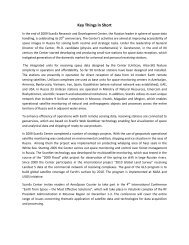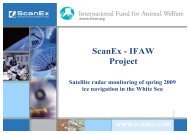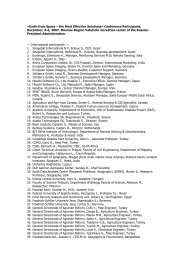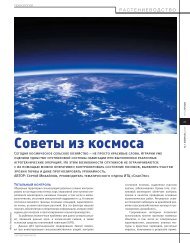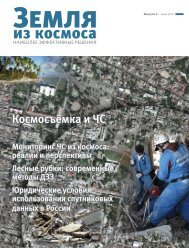RISAT-1. Radar Imaging Satellite
RISAT-1. Radar Imaging Satellite
RISAT-1. Radar Imaging Satellite
You also want an ePaper? Increase the reach of your titles
YUMPU automatically turns print PDFs into web optimized ePapers that Google loves.
Modes of Operation<br />
100 km<br />
(UNQUALIFIED)<br />
100 km<br />
(UNQUALIFIED)<br />
608 km<br />
FRS1&2 MODE<br />
200<br />
km<br />
400 km<br />
(QUALIFIED)<br />
CRS MODE<br />
MRS MODE<br />
<strong>Radar</strong> <strong>Imaging</strong> <strong>Satellite</strong><br />
The active antenna consists of three<br />
panels each of 2m x 2m size, totaling<br />
6x2minall,andisdividedinto12tiles<br />
of 1m x 1m each. Front side of each tile<br />
has a grid of 24 x 24 radiation patches.<br />
Backside of each tile carries 24 T/R<br />
modules, their power supply modules<br />
and controllers. With the help of phase<br />
shifters in the T/R modules, the antenna<br />
beam can be steered in range direction.<br />
Output RF peak power of each T/R<br />
module is 10 watts and the noise figure<br />
of its receiver is 2 dB. The antenna has<br />
its own calibration network to cross<br />
check the performance of its various<br />
elements on ground and in orbit. Input<br />
signals to and output signals from TR<br />
modules are processed using RF and<br />
baseband subsystems. A chirped signal<br />
at 5.35 GHz, having a pulse width upto<br />
20 µ sec is fed to the T/R module for<br />
further amplification and transmission.<br />
The output of the receiver is filtered,<br />
digitised using block adaptive<br />
quantisation and sent to data formatter.<br />
The data from SAR is formatted and<br />
fed to RF transmitter. A solid-state<br />
recorder (SSR) is part of the baseband<br />
data handling subsystem. The payload<br />
data can be transmitted in real time<br />
mode or in playback mode.<br />
It is planned to transmit the SAR<br />
data, with 640 MBPS data rate using X-<br />
band down-link in QPSK mode. A phased<br />
array antenna with dual polarization is<br />
used to overcome the limitation of<br />
available bandwidth. The data rate for<br />
each polarisation is, thus, planned to be<br />
2 x160 Mbps. Data transmitter antenna<br />
will have onboard beam<br />
steering towards the<br />
ground station during<br />
data transmission.




